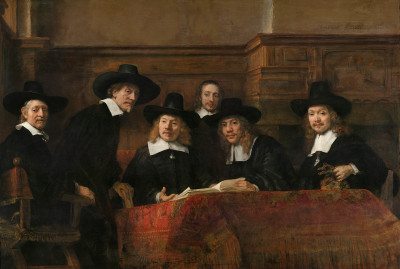Melvyn Bragg on his love of Rembrandt
Melvyn Bragg on his love of Rembrandt
By Melvyn Bragg
Published 28 August 2014
As a major show of Rembrandt’s late works opens, Bragg considers the artist’s achievement as a consummate witness of life.
-
From the Autumn 2014 issue of RA Magazine, issued quarterly to Friends of the RA.
I look at my Rembrandt every morning. It is one of the majestic late self-portraits and I am very lucky to have it. His self-portraits intrigued me when first I saw them and I am increasingly absorbed in them the older I get. He is, for me, the autobiographical master of the human face, peerless, fearless, repaying all the daily attention I can offer.
I am doubly lucky because if I want to see the original of the postcard propped on my desk, I can walk across Hampstead Heath to nearby Kenwood House and see in all its glory Self Portrait with Two Circles (c.1665-69). But the postcard is no mean stand-in. Postcards of favourite paintings are like calling cards from the artists, or aides- mémoire. “Titter ye not”, as the late great Frankie Howerd would say. And remember Ernst Gombrich.
Gombrich spoke of “the beholder’s share”. We all exercise this faculty of imagination. A tiny photograph from our past, with parents squinting at the sun and a tree growing out of the head of a favourite uncle, can provoke a spectrum of pleasure because of what we bring to it. Our share.
So it is with postcards. As I look even now at the small replica of Self Portrait with Two Circles my mind enlarges it. And even on some days, if I merely take it as it is – an ageing postcard – its powers are more than sufficient to remind me of why it matters to me.
Ingmar Bergman, in an interview I did with him more than 30 years ago, talked about the supremacy and the infinite satisfaction to be found in filming the human face. We see that?in many of his best films. In Rembrandt’s self- portraits I see it constantly. From the dashing young man in his early, successful, flamboyant days, with his long earring and opulent confidence, to the almost gargoyle, to the thankfully many studies of himself in later years. He made his face a masterpiece of art.
One characteristic particular to the later paintings is that as an ageing man he could?as easily be an old woman, especially with the bosomy clothing. In some of the portraits you see one eye that is as intelligent as could be, while the other is dead to the world. The expression is more enigmatic than Mona Lisa could have dreamt of.
-

Rembrandt, Self Portrait at the Age of 63, 1669.

Rembrandt, A Woman bathing in a Stream (Hendrickje Stoffels?), 1654.

Rembrandt, Portrait of a Lady with a Lap Dog, about 1662-5.

Rembrandt, The Anatomy Lesson of Dr Joan Deyman, 1656.

Rembrandt, The Sampling Officials of the Amsterdam Drapers’ Guild, known as ‘The Syndics’, about 1662.

Rembrandt, Portrait of a Couple as Isaac and Rebecca, known as ‘The Jewish Bride’, about 1665.

Rembrandt, An Old Woman Reading, 1655.

Rembrandt, A Man in Armour (Alexander the Great?), 1655.

Rembrandt, Portrait of a Blond Man, 1667.
-
In Rembrandt’s self-portraits I see a profound representation of the human condition. In Two Circles, for instance, we see him as a working man, his palette in the foreground. We see him as an aged witness to life – not, in my view, a King Lear as some critics have suggested, much more a Socrates. Deeply thinking through what it is to be him and alive.
The puzzlement at life – that is in his expression. And also the sadness. Perhaps that life is so short or so full of failure or so cruel to passion. Yet there is a stability, if not of contentment then of acceptance.
I had a friend in Cumbria who lived alone much of the time and used to tell me: “I have no problem in suffering my own company.” That phrase comes to mind when I see the self-portraits. And above all, I see them as an attempt to make art out of what we most simply are. Ourselves; the thing we are.
Autobiographical fiction, pursued so eagerly in Western literature – especially in the last 150 years or so – is the nearest we novelists can get to that state of self-portrait, that use of ourselves as the palette. Perhaps that is one of the reasons I have pursued Rembrandt through galleries in London, Amsterdam, Washington, New York. But when we turn away from the self-portraits, there is so much more that he did apart from those internal landscapes. In The Jewish Bride (c.1665-69), for example, also known as The Bridal Couple, painted about the same time as Two Circles and one of my great favourites, he gives us an unparalleled story of conjugal grace, devotion, discreet but complicit sexuality, and the lightness of recognition.
This makes a solemn study lift the spirits and look to what there is in us out there, which most truly tells us who we are and what we are. Like Socrates, Rembrandt is a teacher.
-
Rembrandt: The Late Works is at the National Gallery, London from 15 October to 18 January 2015.
Melvyn Bragg is an award-winning novelist and broadcaster.
-
-
Enjoyed this article?
Become a Friend to receive RA Magazine
As well as free entry to all of our exhibitions, Friends of the RA enjoy one of Britain’s most respected art magazines, delivered directly to your door.
Why not join the club?

-













